IK Multimedia iLoud Micro Monitor Review
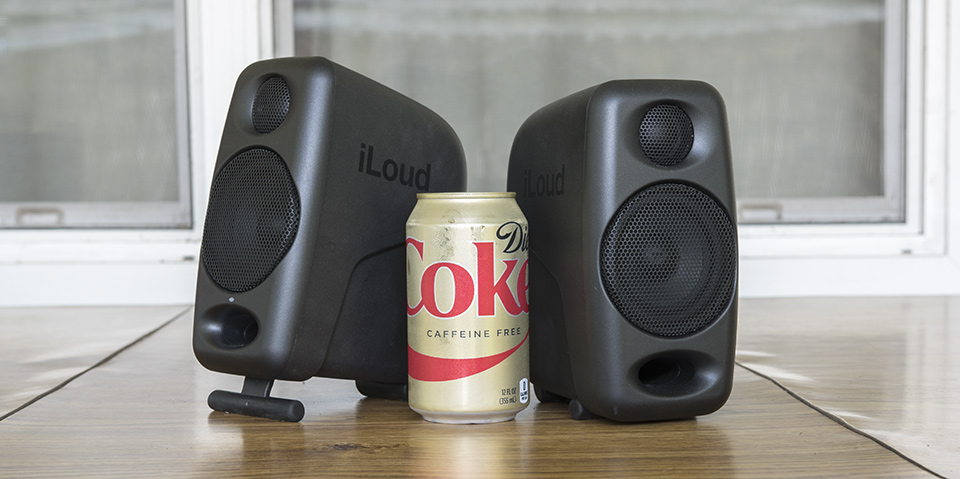
Black water for scale - The iLoud are itty bitty, no joke.
I've never heard of IK Multimedia, but after some digging it seems like these guys make apps for mobile devices, and made a mono bluetooth speaker at one point. The iLoud Micro Monitor is IK's first attempt at a stereo pair of speakers, and based on specs they are trying hard to make a good first impression.
Component Overview:
Grill
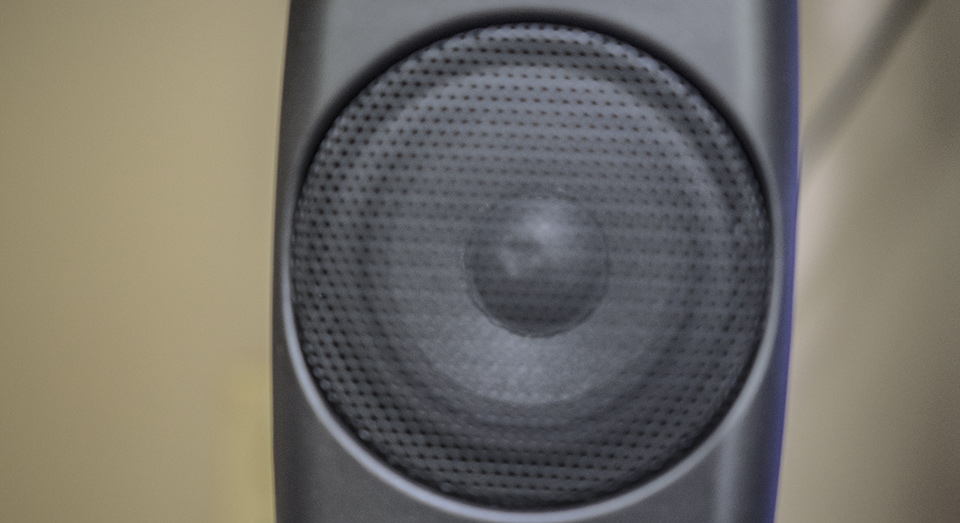
The grills they don't love me
The multi-grill facemask array plastered over the drivers of these speakers are not removeable in whole or part. In defiance of this impenetrable metal mesh, one of these speakers has a dent in the dust cap. Ironically, the dent won't affect the sound quality as much as the grills.
I get that these are portable studio monitors, but in my opinion you should still be able to remove the grills.
Also, there are no visible fasteners on the speakers, so I can't take them apart. Because of these issues I will be using provided photography of the speaker drivers and cabinet internals.
Tweeter
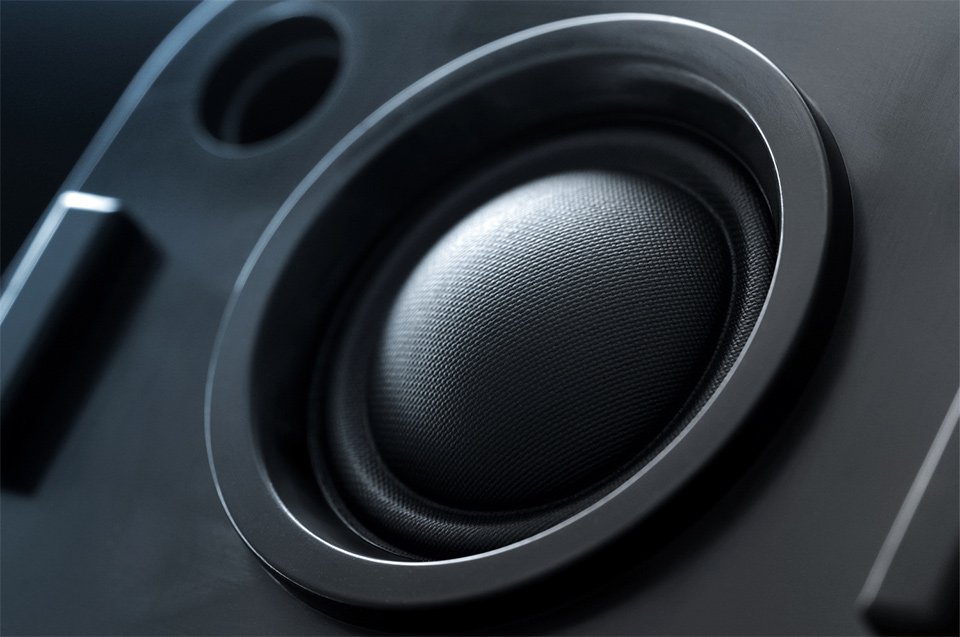
Tiny, deep set, and grilled over. The tweeter has a little waveguide on the face of the speaker, but that appears to be more aesthetic than any kind of functional acoustic device. The deep seating and heavy grill have more to do with the end resulting sound. The deep seating keeps it from being too wide of a dispersion at the very top octaves, a common problem for little tweeters. The very narrow baffle leaves the door open for diffraction issues, because the tweeter is so close to the sides of the speaker.
Woofer
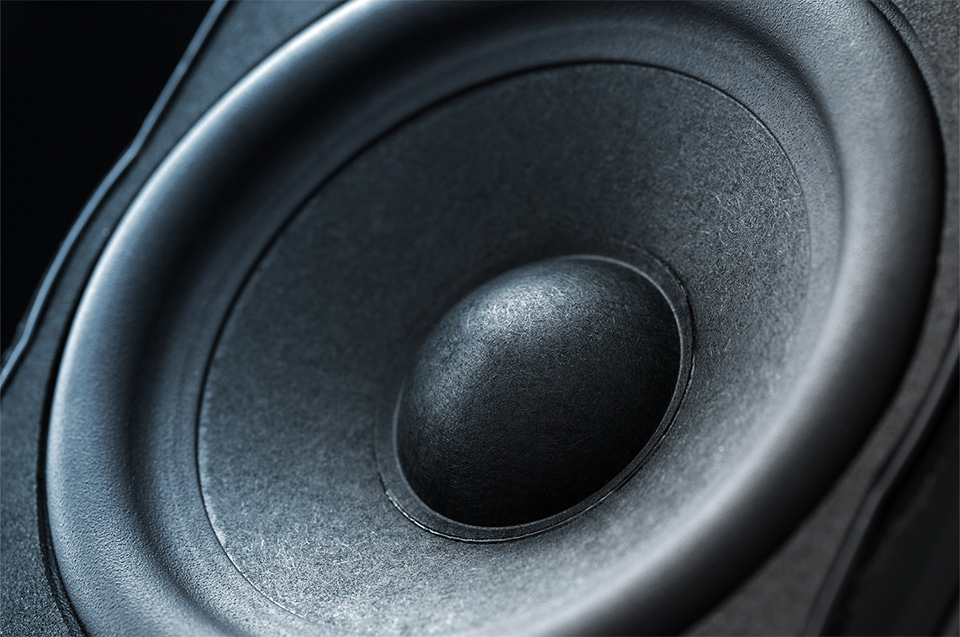
Woofer looks like a wool cone. Might from the SB acoustics factory, or possibly the shop in China that put together the Micca COVO-S. Small size should mean easy integration with the tweeter and limited bass output.
Port
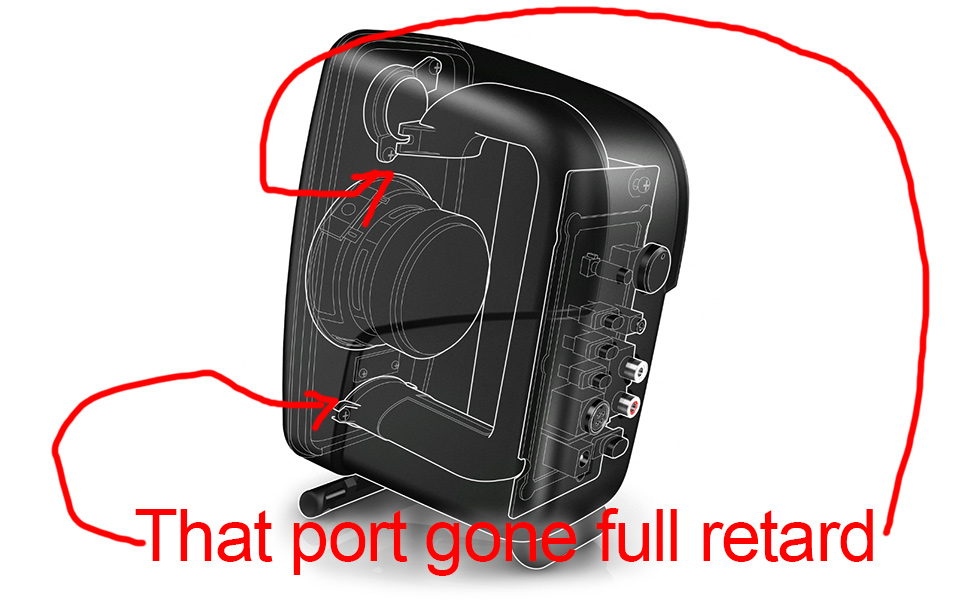
When doing the DSP dance, and tweaking woofer response digitally there is little reason to use traditional box calculations to determine port tuning. These guys obviously took this new found freedom to new heights and tuned for the deepest bass response they could. Long narrow port means deep bass, but also increases the chance for chuffing. Usually ports are put on the rear of the speaker to hide port noise, increase boundary gain, and avoid phase cancellation issues. It will be interesting the see if this frontal port placement will be a problem.
Input/Output and Controls
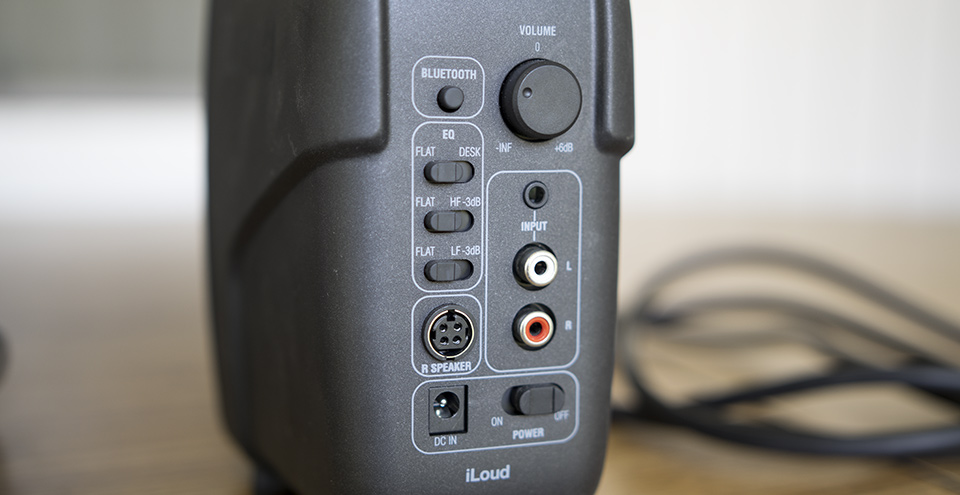
There are EQ options for low and high shelf, as well as a desk mode to be used when the speakers are on a desk surface without stands. We will test the "desk" mode extensively, both in listening and measurement sections of the review.
The iLoud takes in RCA's and 1/8 inch analog, the connectors appear to be quality and never gave me a problem. There is also bluetooth for people that value convenience over audio performance.
Having bluetooth but no SPDIF input is a weird choice. No quality digital inputs means that the speaker is depending on everything in the analog upstream to reject noise, while only having unbalanced inputs. I ended up getting a little hiss in my setup, but was able to turn down the gain on the back of the speaker and send it a hot preamp signal to minimise the problem.
Plate Amp
The amp is hidden inside of the speaker somewhere. When testing the sides of the powered speaker get hot, so I guess that is where it is located. It's got to be tiny, and class-d to avoid overheating in such a small space.
Power Supply and Wires
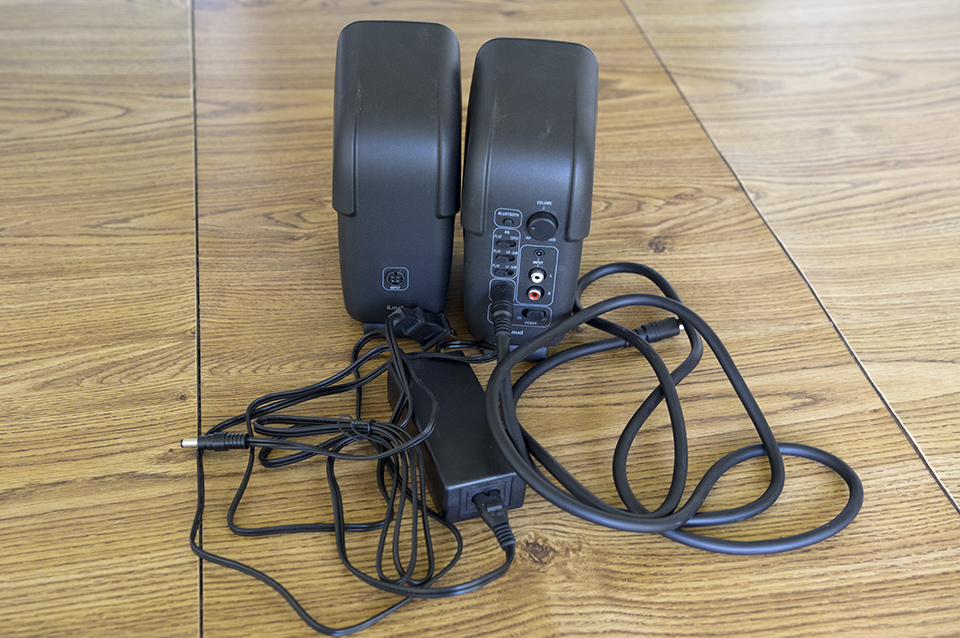
The cable that connects the left to the right speaker is a proprietary 4 pin din plug, and the wire thickness is completely overkill. It's heavy, bulky, and there is no way they needed anything more than 22 awg wire for the amount of power getting sent over this very short length. I even had the wires come unplugged after moving the speakers from the desk surface to stands, partially from the weight of the cable, as well as from the lack of a solid snap connection. If there was one thing I would recommend IK multimedia changing this would be it.
For a portable system I would have liked the power supply to be internal, but that is not the case. The power brick has about the same foot print as one of the speakers. It's a 24 volt 2.5 amp unit, and is ROHS and China export stamped - meaning there is a 50/50 chance of it being an unfused fire hazard, or not having lead solder in it.
Crossover
The DSP bits inside of the powered speaker handle the crossover. Documentation says it's "around 3.5kHz," specs say 3kHz, and my tests showed 2.8kHz. The marketing wank says that the crossover point is high because they wanted it out of the midrange, and can afford to make that happen with the small 3 inch woofer.
Truth is that small woofers will have cone break up much higher than larger woofers, but a 2.8Khz crossover is not really that high, with B&W 686s2 crossing at 3.8kHz and
Dayton B652 AIR crossing at 4.5Khz using first order passive crossovers. Fun part of the sales pitch is a lower crossover point is usually desirable because you can get a wider dispersion out of a dome tweeter than you can a cone woofer.
Cabinet
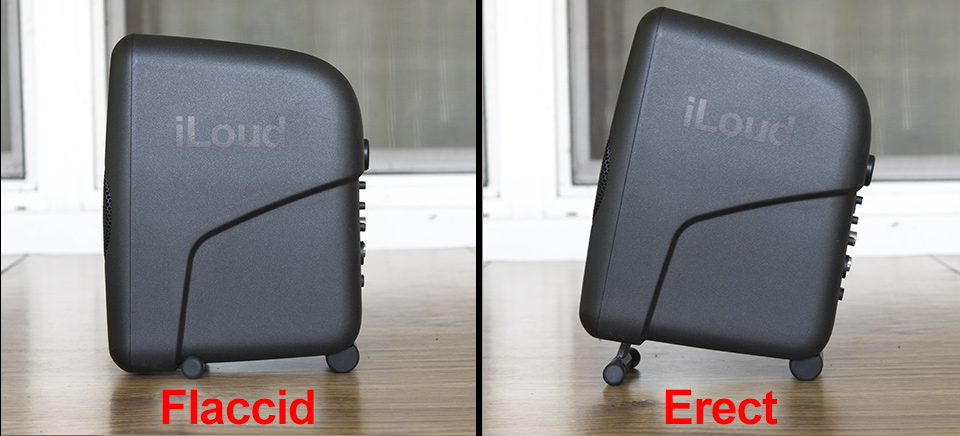
The little kickstand has two positions. Nice grippy rubber feet are built in, and they performed well on my desk surface keeping the speakers from tipping over or rattling about.
The cabinet looks and feels a step above standard Logitech grade ABS. The matte finish is abrasive enough to make little circles of skin cells when I gave it a knuckle wrap. The speakers are obviously hollow, but the smaller the box the less audible it's material properties. The speakers seem to be made well enough to not rattle apart, which is all that really matters at this very small size.
Flat on desktop setup
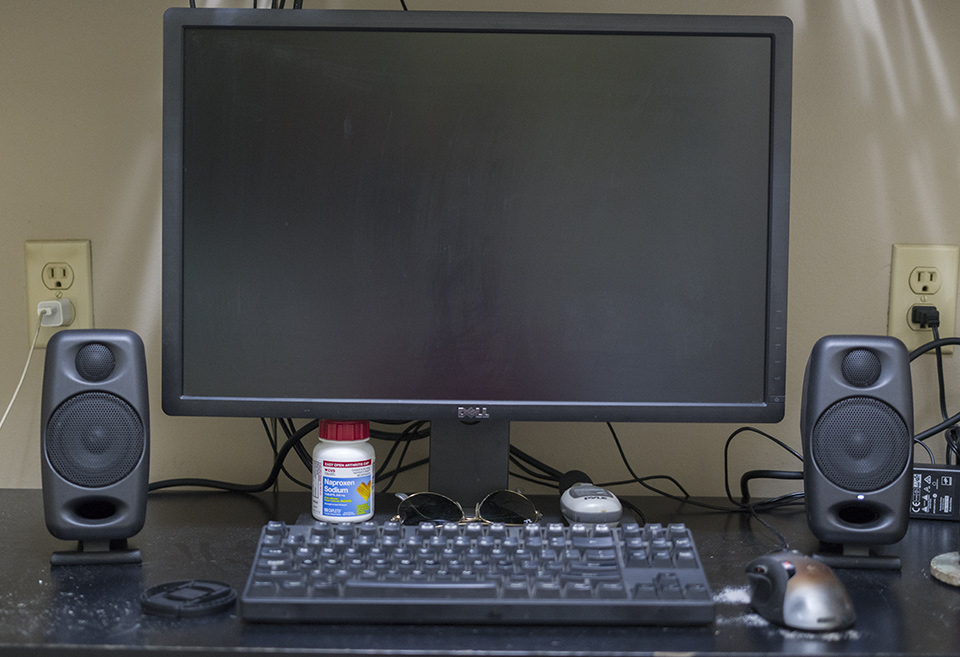
Clear the desk, switch to fully erect mode, and flip the switch to desk EQ - Let the fun begin!
Listening Notes:
The iLoud Micro Monitors are doing a pretty good job.
There is no audible cone breakup, but the upper midrange sounds elevated, making the speakers sound hollow.
The bass is very good, not over done, even though I have the speakers only a foot away from the rear wall. I'm hearing balanced bass response to the 50Hz range - this performance is completely unreasonable for a speaker this size.
Having the speakers below ear level, even with the little kickstand extended I'm looking at the top of the speakers and that means the imaging and detail is going to less than optimal.
Way too much upper midrange. It's really bothering me now.
Performance on stands:
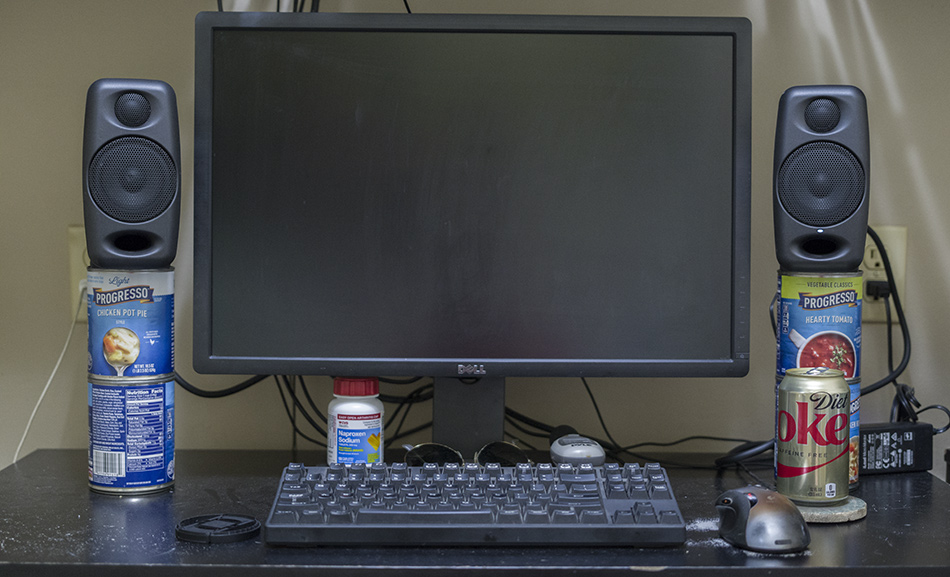
Not digging on the choices made with the "Desk setting EQ" I turned it off and put the speakers up on stands. The best solution for this would be some very short mic stands which would screw into the bottom of the speakers, but my soup towers will have to do.
Desktop Listening Impressions:
Imaging is worlds better with the speakers pointed in the right direction.
A little harsh in upper midrange/treble. This may cause ear fatigue making the speakers hard to listen too for extended periods of time.
Bass response is off the walls bullshit levels of no fucking way possibleness.
Deep, smooth, room filling, rolling tidalwaves of buttery biscuit bass - it might be a bit much, but it's lots of fun.
The speakers are flat to 50Hz without boundary gain.
Slowly increasing the volume on bass heavy songs and I can tell there is a dsp limiter keeping bass response just below the limit of the driver. This means that tone is a moving target, and professional use for mixing will be a lot more complicated.
Unintelligible melodramatic whining of Joy Division are a little too muffled by bass.
If played loudly on sections of music where there is deep bass and not a lot else going on there will be audible chuffing, but it's not really that bad.
Dispersion is surprisingly narrow for such a small speaker. The speaker is not painting the side walls, and in fact I hear mostly direct music.
The little light on the front turns red when the speaker gets angry. I'm pretty sure it's a thermal overload light letting you know that the amp is getting hot, and it also corresponds to a distortion of the treble, so it may just be the limit of the amp. I had this happen a few times, and if you play above 85dB for extended periods you will get used to seeing this light.
The iLoud has proven to me that they do bass. Time to go for a more balanced sound and flip the -3dB bass switch on the back of the powered speaker.
Bass sounds correct... deep and correct. There is just enough to blow your mind without being so much to smother the midrange performance.
A test of blasting music shows that I picked up a predictable 3dB from red light/port chuffing levels. Also, the bass limiter of the DSP does not seem to be messing with the tone of the music as much.
Levels in the upper midrange are still slightly elevated, and it's all the more noticeable with the speaker's bass response being more accurate.
Flipping the -3db switch on the treble does not fix the problem. Instead it just cuts the treble levels so much that the bass is overwhelming again.
SPL Testing
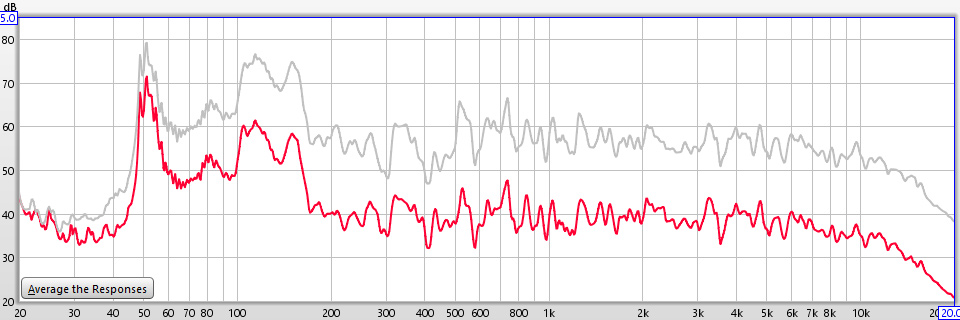
Above is a capture from the Real Time Analyzer showing bass compression while playing Mason's "It Was About Chicago" being played at two different volume levels. You can see the Bass response at 50Hz compress by 8dB as the volume increased by 15dB.
Bass starts to audibly compress at 80dB.
Speakers will play as loud as 96db, but sound horrible and will thermal overload very quickly.
My personal limit settled at 85dB. This is the edge of good - above that I can hear amp distortion even if the warning light is not flashing. Bass is good at this level, but not outstanding.
Using the -3dB bass switch make the music more palatable at lower volumes, and keeps it that way longer.
Best performance between 80-85dB, which is loud enough to enjoy most music, but don't expect to throw a party.
Port turbulence on Deadmau5 I Remember at 87dB with -3dB switch
Measurements:
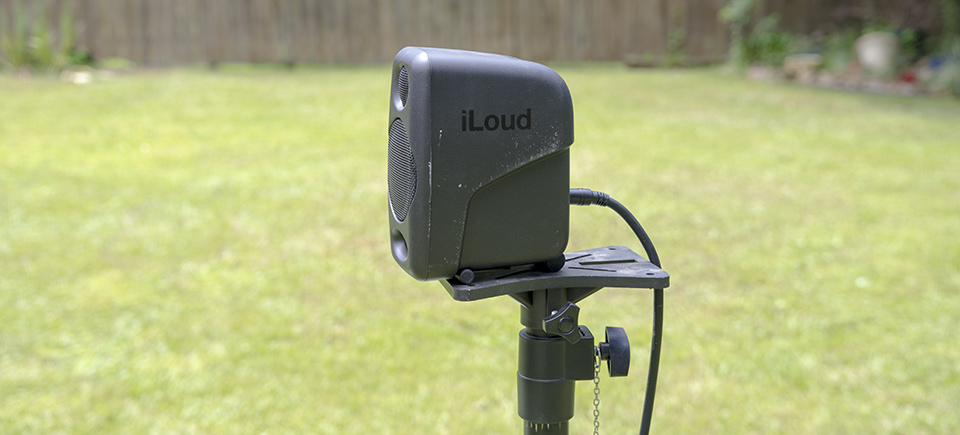
iLoud's looking rugged after getting a little dirty in the outdoor measurement process.
Windowed Frequency Response
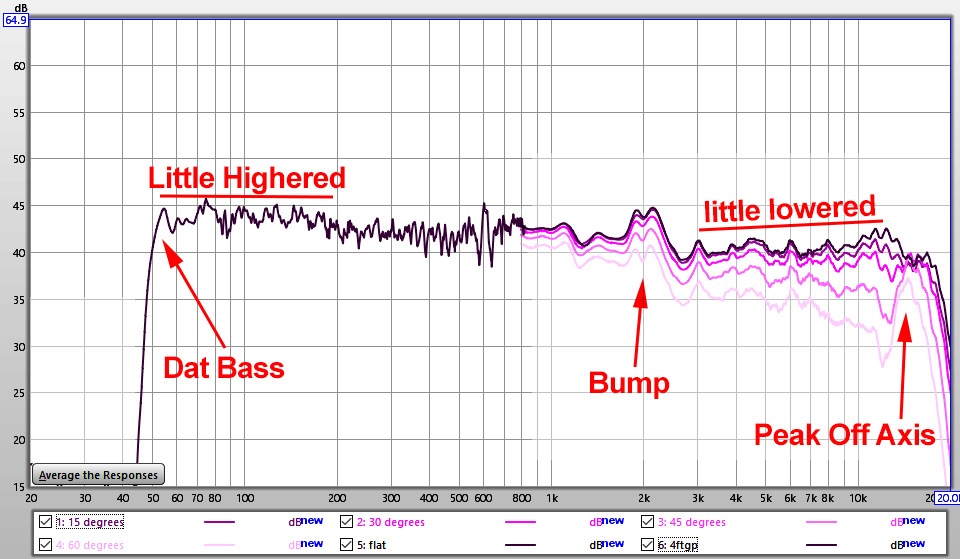
This measurement is a combination of on and off axis measurements above 800 Hz and a ground plane measurement below 800Hz. All reflections have been windowed out of these results. Note that I was not perfectly on axis with the tweeter which accounts from most of the downward tilt of the measured response.
Bump at 2kHz shows up in every measurement and is audible. The 15kHz peak is either from diffraction or a higher order mode from the super steep horn loading. These artifacts are not end of the world bad, but it's a less than the perfect response we were promised.
Close Mic
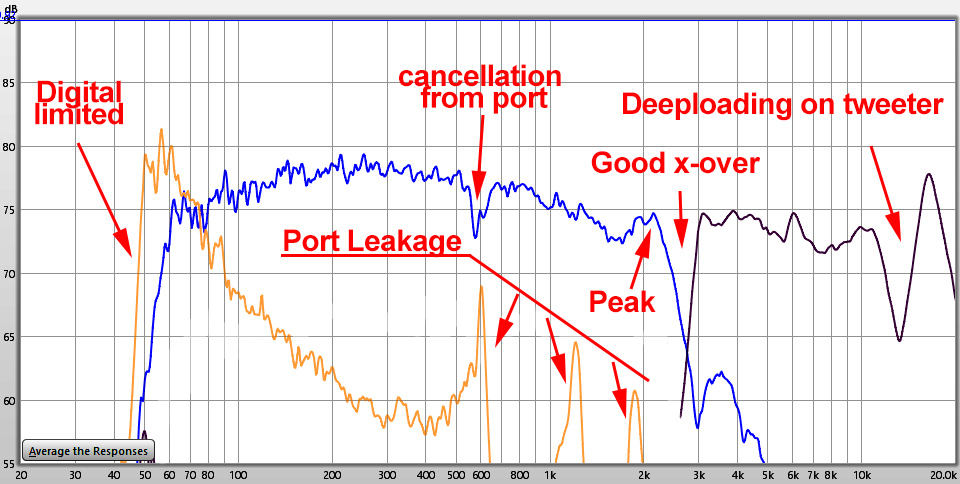
This is a close micing of the drivers and ports. This measurement technique is useful for finding crossover points, and seeing port leakage.
Moving from left to right, The extended bass response is digitally limited to protect the driver from killing itself. There is port leakage/whistling going on 600Hz, 1300Hz, and 1800Hz. The 600Hz leak is loud enough to cancel out some of the energy coming from the woofer. The 2kHz peak on the woofer is here, leading up to a crossover point that is lower than the provided specs. Given that the crossover is handled via DSP there is no way that this just drifted out of spec, I figure that the crossover was changed after marketing had written all of the copy. You can ignore this wild results above 10Khz, close mic measurements don't get along with deep loaded tweeters.
Tone Controls
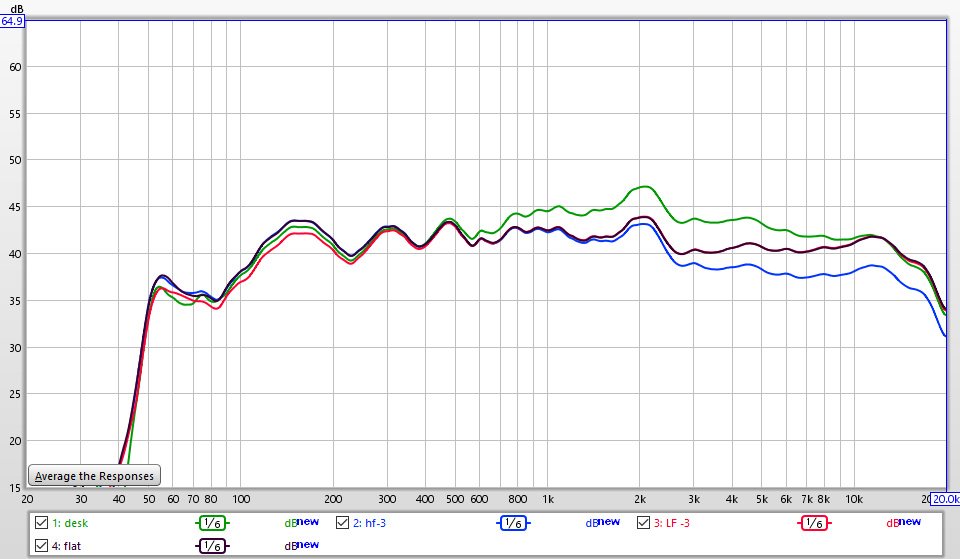
These measurements were done at elevated volumes, which is why the bass response is rolled off and uniform despite EQ options. They also include reflections with 1/6 smoothing to show the tonal differences between EQ options more clearly.
The desk setting is really strange, boosting output in a massive hump centered at 2kHz.
Ground Plane
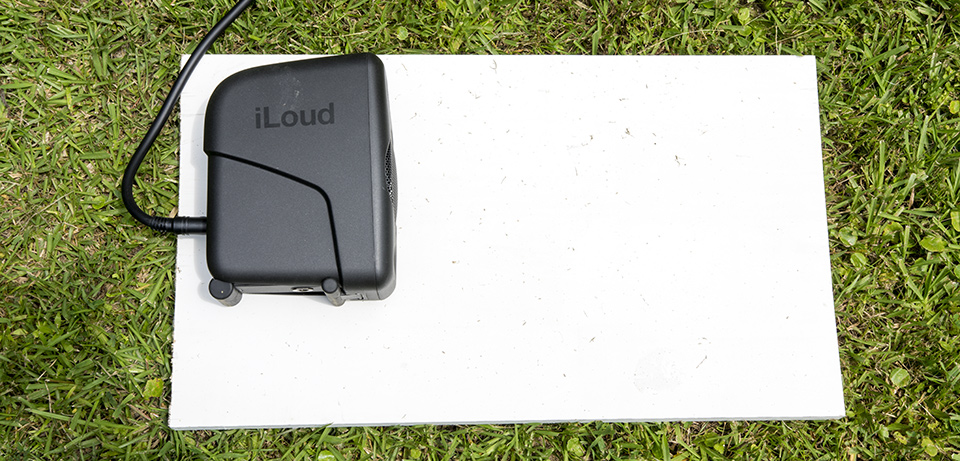
To avoid interference from the floor, you must become the floor.
This is the first time I'm including ground plane measurements in my reviews, so I'll take a moment here and explain the idea. Basically if you put the speaker and microphone on the ground in the middle of an empty field you can avoid the floor bounce and room modes messing up your measurement.
Before I was using just close mic measurements to get an idea of bass response, but that measurement technique will show a rise at the FS of the driver. Ground plane is way more of a pain in the ass to setup, but is as accurate as you can get when measuring bass response.
Ground Plane Bass Scaling
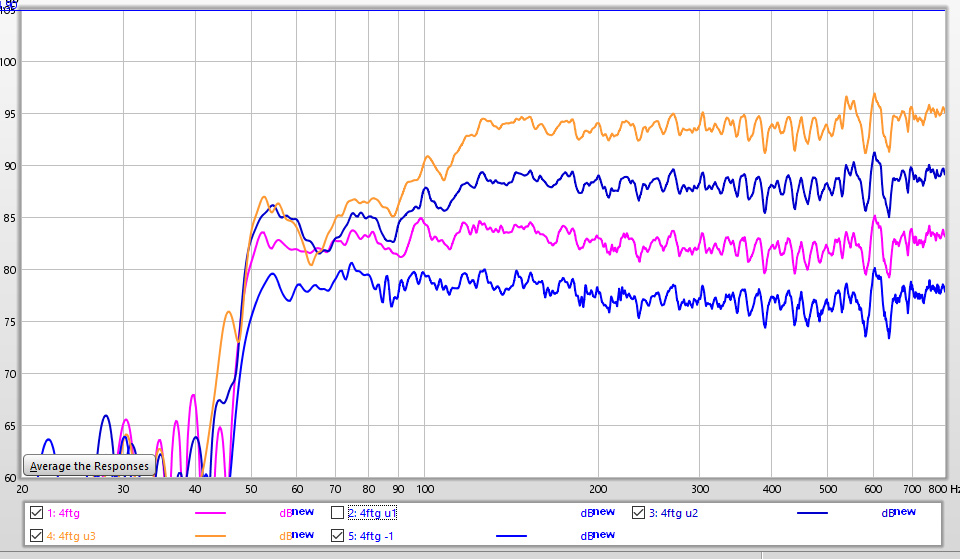
Here you can see the tonal changes as the volume increases.
Bass vs Vanatoo Transparent Zero
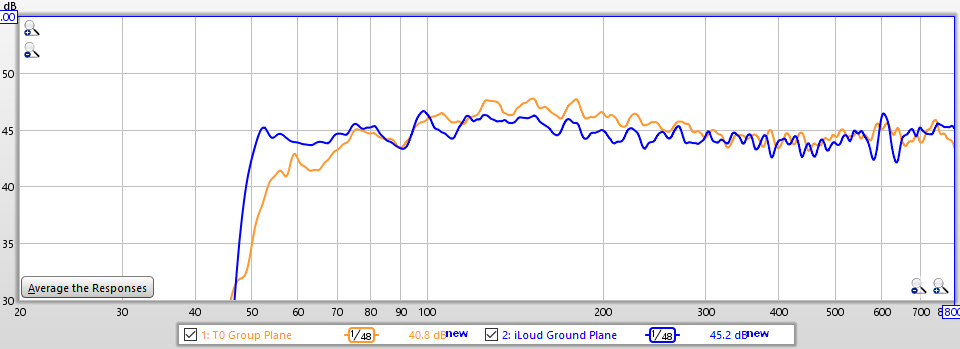
While I had the iLoud out for testing I ran a few dozen measurements of the other speakers I've got in my stock pile, including the Transparent Zero.
The iLoud clearly plays deeper and flater than it's rival the Vanatoo Transparent Zero. The Vanatoo shares similar output limitations, but does not have the obvious tonal changes of the iLoud's DSP limiter. Bass response in a tiny box is about picking which compromise you can live with, both of these solutions are valid.
Right Vs. Left Speaker
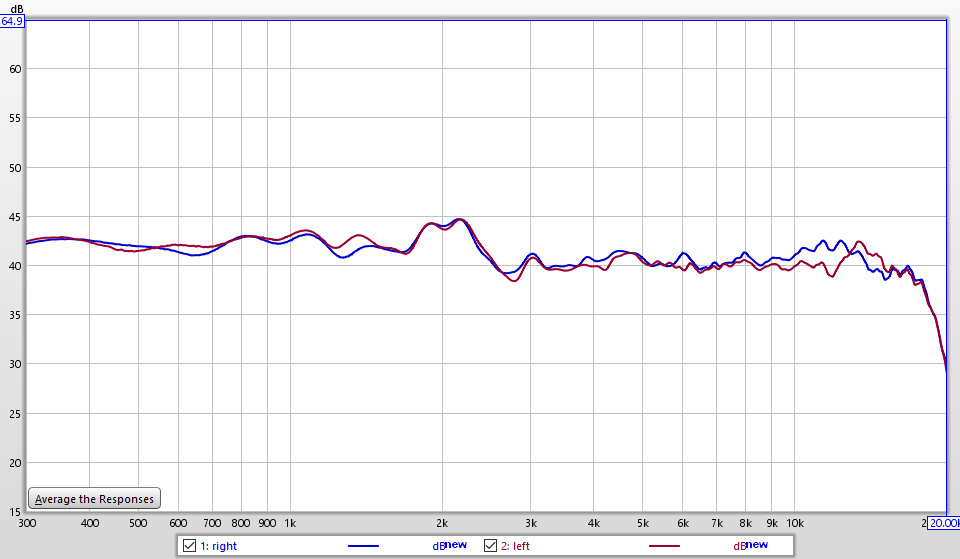
Right and left speakers measure pretty much the same. Variability in upper frequency can be explained by being off axis just a fraction of a degree more or less between measurements. These are impressive results at this price point and this indicates good quality control from IK Multimedia.
Desktop Reflection Simulation
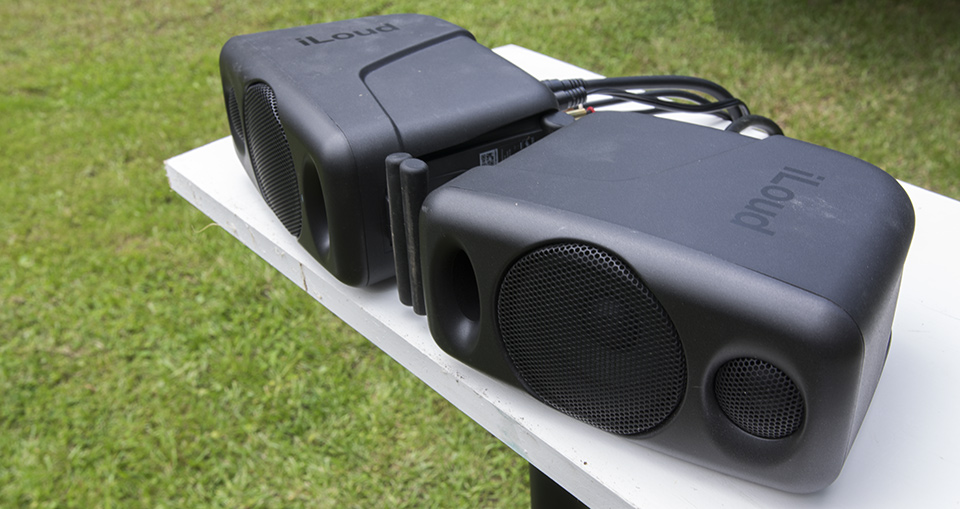
This group of measurements simulate the response you get when having a speaker flat on a desk surface(hint - it ain't good). The measurements are windowed to remove as many unintended reflections as possible.
Kickstand Up vs Down Response
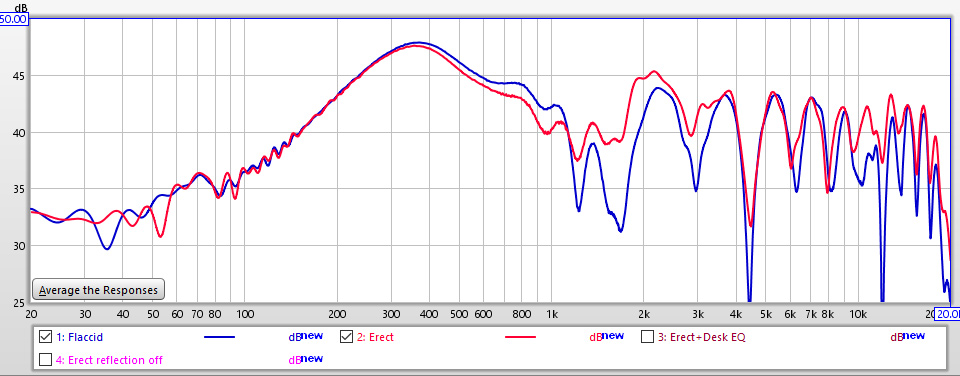
Going erect gets the speaker pointed more directly at the microphone, and as such we can see some gains in the treble response. Clearly the kickstand is a good thing for flat on desk setups.
Reflection off vs on with Flat EQ
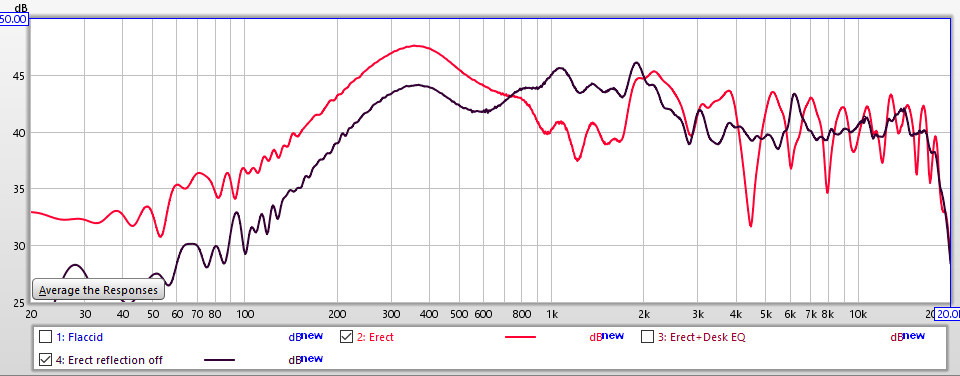
The black line is what we want as a best case response, the red measurement shows the speaker with desk EQ turned off. Treble response looks like a mess, but is at the correct level. The real problem tonally that could be fixed with EQ is the boundary gain, where the woofer and it's reflection start acting like one source. This starts around 800Hz, and gains max 6dB by 100Hz.
Reflection off vs on with Desk EQ
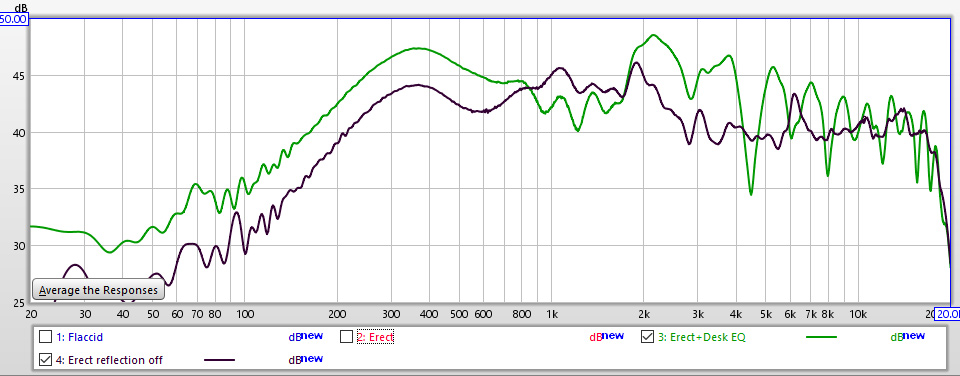
We can see the Desk EQ tries to pick up the midrange to match the level increase in the bass. This desk EQ tries real hard, and almost get it right, but does not boost the treble at all, and the boost is centered right at 2kHz, making a flaw in the speaker's natural response way worse.
Priority should always be to have the speakers on stands, but if you are forced to have the iLoudMM on a desk surface I recommend not using the Desk EQ setting, and instead selecting the -3dB Low self. You will be left with a smooth hump between 150Hz and 700Hz, but it's better than missing treble and peaky midrange.
DSP Correction
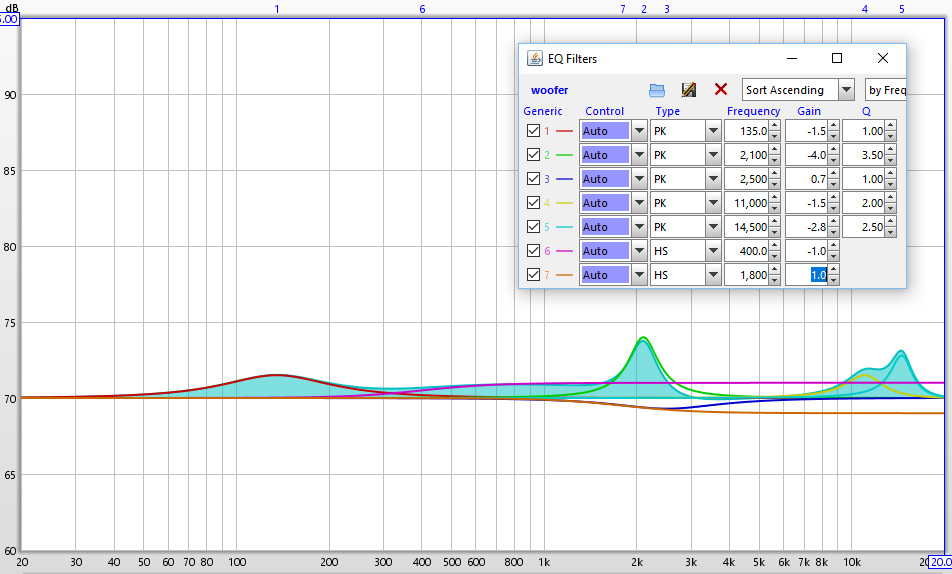
This correction is not a drastic change. There is a little of the upper bass pulled out for added clarity, Took out a very slight forward midrange and of course the peak at 2Khz. The tweaks above 10kHz helped clear up some issues with the treble that appear off axis and can sound harsh with cymbal heavy music.
Final Thoughts:
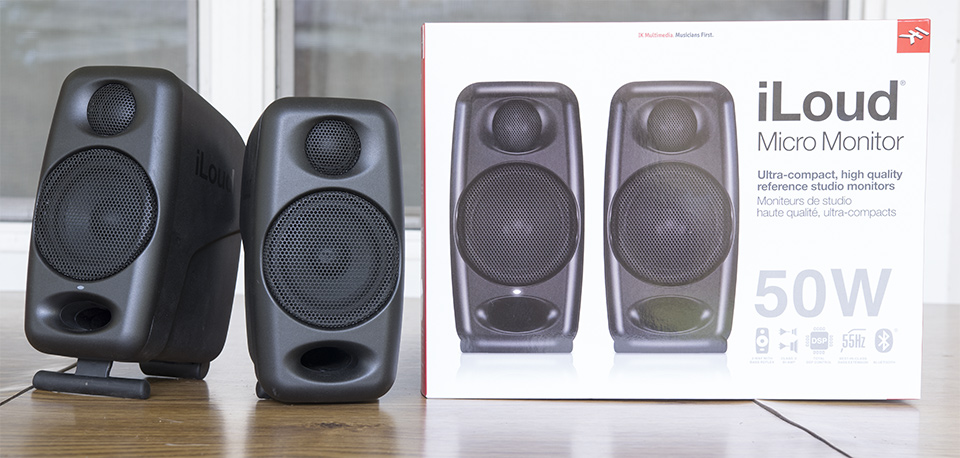
The randomness of the DSP limiter for bass makes these speakers very hard to recommend for the intended purpose of monitoring. The amps are good, until they overheat, or distort. This happens too early, and yet again I think the DSP limiter should have been setup to deal with over driving the amps, cutting output instead of distorting. Desk EQ setting are not good enough, the treble drop off is inexplicable.
All that said, If you need something super small that puts out clean flat sound to 50Hz at low listening levels, the iLoud Micro Monitor is your speaker. There is literally nothing else on the market that achieves this kind of performance. This speaker has the right kind of compromises, and is so very close to the ideal desktop speaker. With the DSP correction applied the sound quality of the iLoud at low levels sounds damn near as good as quality monitors like the
JBL LSR305, but takes up 1/8th the space.
I expect the IK Multimedia iLoud Micro Monitor to blow a lot of people away, and to sell like hot cakes. This is truly a groundbreaking speaker, and at it's price range it's an easy recommendation to someone in this niche of the market.
Thanks and credit:
Special thanks to the Audiophile subreddit for throwing their weight behind me, and being a big part of getting this review sample in my hands.
Also, this review was made better by my Patreon supporters, who are the best in the world at being patient.
Click here to buy the iLoud Micro Monitor Speakers
Click here to download the DSP correction for the iLoud Speakers
Other content you may like:
- Vanatoo Transparent One Review - Software update brings new standard of performance!
- Lone Star Audio Fest 2018 - Staying up late, drinking too much, smoking like chimneys!
- Andrew Jones goes back the be begining, ELAC B5.2 Debut 2.0 Review is up!
- New Scores for all reviewed speakers - Compare and sort for fun!
- Creative Sound Solutions DIY Solution for the high end - CSS Criton 1TD v2 review is up!
- Dayton Makes a Budget Desktop speaker with a crossover - Dayton Audio MK402 review is up!
- Smaller than small, deeper than deep - iLoud Micro Monitor review is up!
- Vanatoo's new speaker, The Transparent Zero review is up!
- SVS Prime Bookshelf Review is now available for your viewing pleasure
- ELAC A-Stock UB5 Listening Impressions are up!
- 30 years in the making, the ancient Bose 901 finally gets measured - The Bose 901 review is up!
- Lock and load, we are hitting the bottom of the barrel with both barrels - The Logitech z313 review is up!
- Bulletproof speakers... No, it's just the B&W 686 S2 Review!
- Declare independence from the British sound! - The KEF Q300 review is up!
- Recommended System Finder - Just in time for the Holidays!
- JBL LSR308 Studio Montor - Super Massive Epic Review!
- Two years after starting this site I finally get around to talking about my stereo.
- Small and cheap speakers transform into retarded and good... Micca COVO-S Review!
- AMT tweeter on a B652? The Dayton B652-AIR is reviewed for great justice!
- JBL LSR305 Studio Monitor Review!
- Zu Essence Review!

